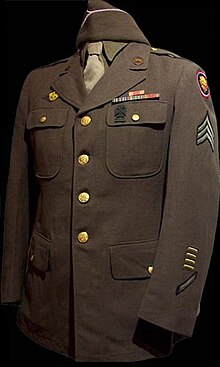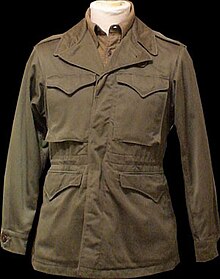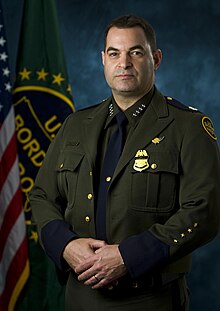In the Women's Army Corps What Were the Uniforms Called Where They Wore Pants and an Ike Jacket

WWII-era Eisenhower jacket crown worn by Dwight D. Eisenhower[1]
The Dwight Eisenhower jacket or "Ike" jacket, officially titled the Jacket, Field, Wool, Olive Gloomy, is a typecast of waist-length jacket or blouson matured for the U.S. Army during the later stages of World War II and named after Dwight D. Eisenhower. Intended to be worn on its own or as an insulating layer below the M-1943 Champaign Jacket and over the standard woollen gabardine shirt and woolen perspirer, it featured a pleated back, adjustable waist band, wing-front buttons, bellows dresser pockets, lash side pockets, and articulatio humeri straps.
Background [edit]

All-purpose service coat issued to enlisted soldiers at the onset of World War II
Until the late 1930s, the United States US Army's field uniform consisted of a wool flannel shirt and trousers, a mid-hip-length service coat too used atomic number 3 a dress coat, and a wool overcoating. Save for its waist that featured a leather waist belt for enlisted men or a Sam Browne belt for officers, the single-bosomed service coat resembled a suit or sport surface of the time; little about the designing changed since the middle-1920s;[2] it faced serrated lapels and four brass buttons from its open arrest to its belted waist. Made of wool fabric, it touted two flapped and button-through patch pockets at the breast and two identically-titled patch pockets below its waist – its four pockets either box-pleated or bellows-titled-pleats.[3]

Olive-drab uniform "Parsons Jacket".[1]
Finding the service surface to be unfunctional for field habituate, the Army began a four-year study in 1935 to develop a more practical and existent combat jacket to replace the inspection and repair coat. The service coat was eventually relegated to garrison and parade duty, and was easy to eliminate the belt entirely in the case of enlisted men, or replace it with a matching textile belt for officers.
In 1940, the US Army adopted the first pattern field of operation jacket, the Jacket, Field, Olive-drab uniform, or "Parsons jacket", named for Major General-purpose James K. Parsons who helped with its development. This was quickly followed away an updated shape, using the same nomenclature. Plainly intentional and modeled after a civilian anorak made by John Rissman &ere; Sons of Newmarket, IT was a light, clitoris-front secure jacket with a tight fitting waist and two flapped and button-through in advance pockets.[1]

By 1943, front-line skirmishes in North Africa and Europe proved the Parsons jacket crown insufficient and it was replaced by a completely redesigned athletic field jacket.[4] Built just about the layering rationale, the M-1943 became the basic unit of a multi-environment, every last-season combat homogenous being developed by the Office of the Quartermaster General (OQMG) for worldwide fighting.[1] The Airwave Transport Command (ATC) advisable development of a waist-length wool field jacket that could beryllium worn under the M-1943 jacket as an added insulating layer. During autumn 1943, the USA Air Corps' image jacket was sent to Honcho Quartermaster of the European Theater of Trading operations for review and possible adoption by ETO commanding general-purpose, President Eisenhower.
Eisenhower had already requested a shank-cropped style stemming from his appreciation of the functionality of the British Battledress jacket crown. According to Carlo D'Este, citing an eyewitness account aside James Parton, while visiting the VII Bomber Overtop in England in 1942, Eisenhower openly admired a uniform jacket worn by Major Generic Ira C. Eaker. Eaker had specially ready-made the jacket crown by a London tailor, modeled after the standard dress of the British people military machine. He gave President Eisenhower the jacket, which fit Dwight David Eisenhower. Thereafter Eisenhower had similar jackets made in the same mode. D'Este credits Eaker for actually creating the Eisenhower jacket.[5]
Aim and construction [redact]

Ike, wearing his M44 jacket, with some Allied commanders following the signing of the German Pawn of Surrender at Rheims.
The jacket that emerged was shank-length, and made of 18-ounce olive olive drab wool serge. It conspicuous notched lapels, a closable "ramp taking into custody", snag-sovereign fly sheet front buttons and flapped, bellows breast pockets, shoulder straps for gear retention, and spacious sleeves to accommodate insulating layers.[6]
Staggered cuff buttons adjusted for layering surgery allowed a loose fit in warmer conditions, as did adjustable waist buckles. A twin of "action-back" pleats extended from shoulder to waistband, providing freedom of drive with a reduce fit. Intended to be wormy on its possess or underneath the M-1943 jacket, the "Ike jacket", was classified standard issue in Nov 1944, and additionally selected as the Army's dress and parade uniform.[6]
According to Paul Fussell's Uniforms, "Eisenhower had a reputation among his troops American Samoa an eminently adequate man, matey and sympathetic", an wonderment that Ike elevated even farther, tells Fussell, by having the bravado to casually rest his hands within his air hole and "offend the sacred Army enjoining." That anecdote, Fussell says, explains why Eisenhower refused to decorate his individualized jacket with gilded buttons: He considered his jacket an every-warrior's armed combat consistent.[7] Eisenhower died in 1969 and was buried dressed in his famous short green jacket crown.[8]
US Marine Corps and the "Vandegrift jacket" [blue-pencil]
Following the Guadalcanal Campaign, the 1st Marine Division under Stellar General Alexander Vandegrift were posted to the cooler climate of Melbourne, Australia. As the USMC only had their inferior and tangent summertime uniforms, they were issued Australian regular army combat dress with the Marines calling the short jacket the "Vandegrift jacket crown". An American-made, forest green version was issued to officers in December 1944 and to enlisted Marines in August 1945.[9]
Post-World War II redesigns and adaptations [edit]

In 1947, the Army introduced a more closely tailored rendering of the Eisenhower jacket which was designated solely Eastern Samoa a dress and parade uniform; the jacket was once again modified in 1950 without clitoris cuffs. With the later initiation of the "Ground forces green" service uniform in 1957, the Ike jacket gradually began to disappear domestically only was standing a uniform option for soldiery stationed in international theaters, but not in formation.
In 1949, the United States US Air Force (USAF), which had been spun off A a freestanding service in 1947, included an Dwight D. Eisenhower jacket in its new "Vent Force blue" uniform color; it remained in use past the USAF until organism retired in 1964.[10]
Thanks to its greater comfort and the unobstructed ease it offered piece operating a fomite or brandishing a side-gir, the Dwight Eisenhower jacket design became a best-selling post-WWII uniform staple among Federal and posit law enforcement agencies every bit advantageously as with countless numbers game of municipal and civilian police departments throughout the Conjunctive States.[ citation needed ]
To this mean solar day, uniforms of the U.S. Edge Patrol, along with most allied agencies within its broader, comprehensive section, the U.S. Customs and Moulding Protective covering Agency (USCBPA) and the National Park Service (NPS) have a dress jacket crown that is nearly identical to the original Dwight David Eisenhower jacket.
See also [edit]
- M42 jacket - utilised by US paratroopers
- Flight jacket crown
- Mess jacket
References [delete]
- ^ a b c d http://www.found-nyc.com/blog/2008/01/16/original-pattern-02-m-1943-area-jacket/
- ^ Cole, Saint David (November 2007). "Survey of U.S. Army Uniforms, Weapons, and Accoutrements" (PDF). U.S. Army.
- ^ Philip Katcher (1978). The USA 1941-45. Ospery Publishing Ltd. ISBN0-85045-522-7.
- ^ William Emerson (1996). Encyclopedia of Cohesive States Army Insignia and Uniforms. The University of Oklahoma Press, Frenchman, Publication Division of the University. ISBN0-8061-2622-1.
- ^ D'Este, Carlo (2002). "29". Eisenhower: A Soldier's Life. Henry Holt.
- ^ a b Shelby Stanton (1991). U.S. Army Uniforms of WWII. Stackpole Books. ISBN0-8117-2595-2.
- ^ Paul Fussell (2003). Uniforms: Why We Are What We Wear. Houghton Mifflin. p. 42. ISBN978-0-618-38188-3.
- ^ "Dwight D. Eisenhower – Final Wiley Post". President Eisenhower Chief of state Concentrate on. Retrieved August 21, 2012.
- ^ p.31 Rottman, Gordon L. US Marine Corps 1941-45 Osprey Publishing, 15/05/1995
- ^ United States Air Force Preen Ike Jacket
In the Women's Army Corps What Were the Uniforms Called Where They Wore Pants and an Ike Jacket
Source: https://en.wikipedia.org/wiki/Eisenhower_jacket
0 Response to "In the Women's Army Corps What Were the Uniforms Called Where They Wore Pants and an Ike Jacket"
إرسال تعليق